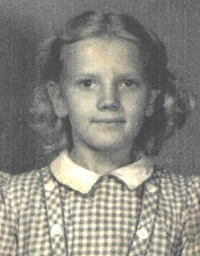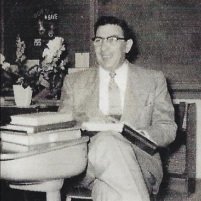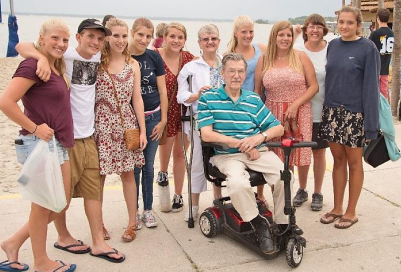Living a Good Life: Shirley Smith
Shirley Bowery was born July 2, 1938 in Wilkes Barre, Pa, and lived on what she describes as a “subsistence” farm. She is the fourth of five children, having two older brothers and a sister, who was 9 years and 364 days older than her. Her sister Thelma, the youngest of the family, was born three years after Shirley. It was like two families, with the older siblings taking care of the younger ones.
Shirley was strong willed as a child and was very determined to get her way, sometimes with tantrums. During one of these episodes she was offered a penny to stop crying, but she held out for a nickel (which back in those days was enough to buy an ice cream cone).
She has many happy memories from those days on the farm. They loved real hay rides, jumping in the hay, and climbing trees. Shirley made pets of the farm animals (including a nanny goat). Kindergarten was not required and transportation was not provided, as a result, she started school at first grade, having been taught all the nursery rhymes by her older brothers and sisters. She was a good student and enjoyed school. Always competitive, Shirley remembers taking the first seat for spelling from a child who had a disability (that she now realizes was probably from polio). She always felt badly about it.
Once they were old enough, everyone on a farm had to help. Just like her older brothers and sister, Shirley had chores on the farm. Her job was to feed the chickens. She remembers the day she felt too tired to feed those chickens, and was too tired to hold her 9-month-old niece. Finally, the family doctor was called and her parents were told she had the “the flu or grippe” and was given 7-Up to keep her stomach settled. When she was unable to walk she was taken to the Contagious Hospital. A spinal tap determined it was polio. She had spinal polio - from the waist down there was minimal movement. The family was quarantined, but no one else got the virus. During the quarantine period at the Contagious Hospital, Shirley could only see her family through a window. Her diversion was a radio and a pile of books.
After three weeks (or so) she was moved to the Home of the Merciful Savior (HMS) in Philadelphia, which was a residential facility for polio patients. She remembers receiving better care there. Having minimal movement from the waist down, Shirley was happy she could wiggle her toes!
Shirley hoped to walk without crutches. She also remembers the nurse in charge, Miss Knee, ”who ran a tight ship”.HMS was founded in 1882 by Helen Innes. Helen and her husband, an Episcopal minister, had custody of a boy with disabilities. They could not find an appropriate home for this child so Helen took on the task and thus began a special rehabilitative facility where all children were accepted, without a fee. HMS pledged, “the care, support and maintenance of children crippled by disease, accident or any other way.” Children received the best medical and surgical treatments at the time. Through the years, classrooms and a school program were added. The instruction was in the basics and in trade skills. (Although HMS was a residential facility for polio patients, it is now a residential facility for children with cerebral palsy.) When Shirley arrived there in 1950, she saw what looked like a typical ward with beds lined up side by side in rows. That’s where she met Annie, an older girl also rehabilitating from polio, “who frightened her with her gruff voice”. Annie still walked with crutches.
She lived at HMS until she was 17. Every Sunday, her parents made the 200-mile round trip to visit to see their daughter. As Shirley grew she “moved up” upstairs where the “big girls” lived. She never felt abandoned. In fact, she created a new family for herself. Annie, “with the gruff voice” became one of her dear friends.
Source: widener.philasd.org
Shirley’s treatment included the “Sister Kenny” method. Australia’s Sister Kenny had some success with her controversial method of treatment for polio survivors (which was adopted in the US in 1940). The treatment involved using moist hot compresses to ease muscle spasm pain and gentle exercise of the affected limbs to reeducate the muscles.
She remembers the use of heavy, wet, woolen army blankets on her weakened legs as well. She started using crutches and was fitted with KAFOs (long leg braces).
Little did Shirley know, but HMS would have a far more special connection for the young teen than “just” polio recovery. A boy named Fred Smith, from neighboring Glenside, had also rehabilitated at the same location. He was there from ages 3 to 6, many years before her arrival. Their paths would cross much later.
Fun Loving Shirley at HMS
From HMS, Shirley went to a school for children with disabilities, the Widener Memorial School on Olney Ave in Philadelphia. Upon admission, Shirley skipped a grade and entered high school. That’s where she would meet and fall in love with fellow student and polio survivor, Fred Smith. Although he left Widener and graduated from suburban Cheltenham High School, Fred would return for visits at his alma mater.
The Principal of Widener toured the country to find the best practices in education for children with disabilities and the result was the development of state-of-the-art facilities. Shirley arrived while it was still under construction.
Mr. Werlinsky at Widener. Source: Shirley Smith
Shirley has fond memories from her days at the Widener School. One is of a dedicated teacher, Daniel Werlinsky. He had an “inspiration board” in his classroom that featured fellow polio survivor, Franklin Delano Roosevelt. Mr. Werlinsky was a hero for all the children at the Widener Memorial School for Children. Another happy memory for Shirley was when her class at Widener was given free tickets to see the Philadelphia Phillies. They were playing in Shibe Park (which would later become known as Connie Mack Stadium). It was a 3-mile trolley ride down Broad St. “We all got to the ballpark on the trolley car.” “We were a sight to be seen, a group of students with crutches all piling up into the trolley to go to a Phillies game.” At Widener there was a model trolley car for students to practice on, but the challenges of getting onto a real trolley car left them in giggles, not making the trolley car operator very happy !
Shirley graduated from Widener and went on to Temple University in Philadelphia. She lived in a dormitory made from an old brownstone that the University had gutted, making the building accessible for students in wheelchairs (unusual in the 1950’s). There was a ramp in the alley to the first floor, where they had rooms. Graduating in 1959, she was ready to start teaching. It didn’t take long for her to discover that a person with disabilities was not to be hired by the Philadelphia School District. She was hired at her old alma mater, Widener. Shirley taught for four years and received her Special Education Certification in 1963.
Shirley and Fred were married in June of 1959. The newlyweds started out living in an apartment close to Widener and eventually settled in Fred’s home community of Glenside. After the birth of their first child, she was a full-time mother enjoying her two daughters. She stayed active outside the home, tutoring and teaching Sunday school.
They enjoyed their new home, and discovered that two parents with disabilities was an exciting new frontier. In spite of them both requiring crutches and braces, neither Shirley or Fred were one to shy away from new adventures with their children. The family went camping every summer, traveling to many places, ranging from Prince Edward Island in Canada to Disney World!
When both of the girls were in school she went back to work at Widener, teaching middle school students. She received her Master’s degree in the Psychology of Reading in 1976, teaching full time until 2002. One memorable student, living with severe cerebral palsy, used head gear to push the keys of the typewriter. One day she wrote “It is good to have a teacher that is handicapped, because they understand.” Recently Shirley told her minister, who also has a disability, how much it means to have someone as a pastor that truly understands. Her minister replied “It is because of you and Fred that the church was ready to have a Rector with a disability”. They had paved the way.
All throughout her life, she has seen her glass as being “half full”. In the 1950’s there were no polio support groups. Beginning at HMS (the “Home” as she describes it) Shirley and her dear friends became like sisters. Annie, Sonia, Mary-Lou, Mary, Alice, Nancy became a family.
HMS Sisters (“The Big Girls” comparing braces in 1954. (Shirley 2nd from right).
While at Temple, polio survivor Judy joined the sisterhood. They were an extraordinary group of support for each other. Always present, the “sisters” shared a lifetime of events that surpassed the pain and disability that came with polio. They shared: weddings, births, child-rearing, employment and everything life had to offer.
The couple were active participants at their church, with their family, and in their local community. They both became engaged with an Abington, PA based Post-Polio Support Group. They were both visible volunteering at the “Casual Coffee Moments” Post-Polio Conference, with Richard Bruno, HD, PhD in 2015.
Given that she taught middle school for 35 years, Shirley Smith doesn’t shy away from a challenge. She has served on the Task Force on Disabilities and on the Episcopal Church Steering Committee distributing grants from endowments to designated causes foreign and domestic.
Both Fred and Shirley worked full time until retirement. Fred maintained his home-based tax business until 2017. Their daughters blessed them with seven grandchildren, sharing family vacations and frequent celebrations.
Although it came on more quickly for Fred, PPS has been gradual for Shirley. They are fortunate to have a PPS knowledgeable rehabilitative physician locally and sought his care. Shirley is determined to stay as active as possible, naps and rests when she needs to and stays safely active.
The Smith Family - Source Shirley Smith
The use of a scooter, has expanded her range like using it for nature walks. She also uses it when she is not wearing her braces. She is reluctant to use it for everyday use, and walks as much as she is able realizing that it is good for her wellbeing.
Now in her early 80’s Shirley remains active. After losing Fred in 2019, she now enjoys the company of one of her granddaughters on a full-time basis. She credits her positive attitude on the resilience she developed of having been raised on a farm and being nurtured as a child.
Shirley displays a “can do” attitude and is a problem solver, viewing barriers only as “challenges to be overcome”. She would always problem solve with her ever practical husband and together they approached things as a united front. She can do most things and thrives by not having to do any of them alone. She approaches everything she does with passion and enthusiasm and has thrived in her accomplishments.
You are living a good life, Shirley Smith.







